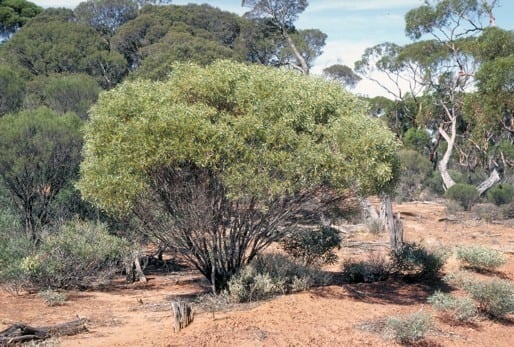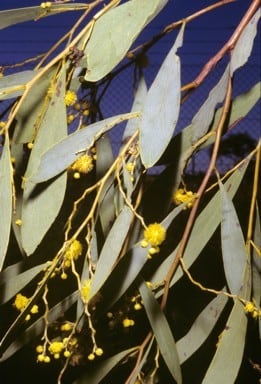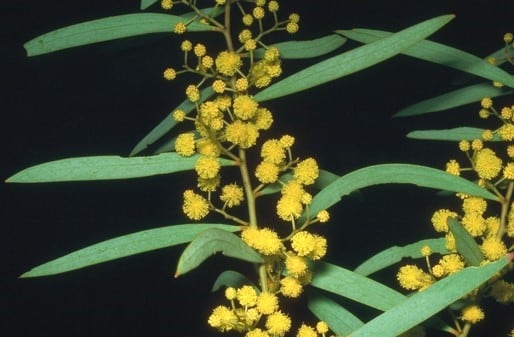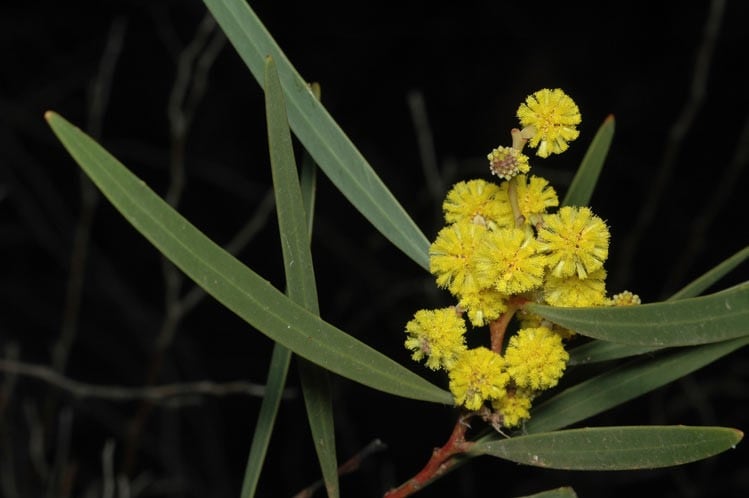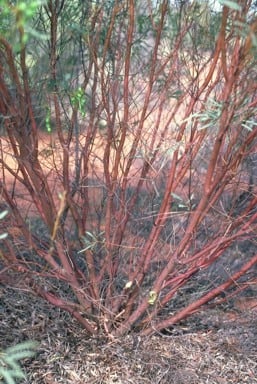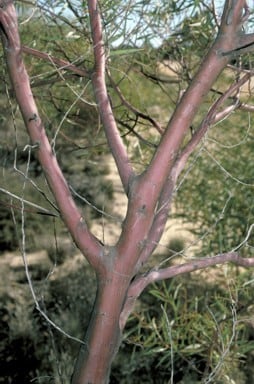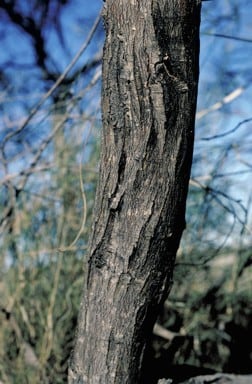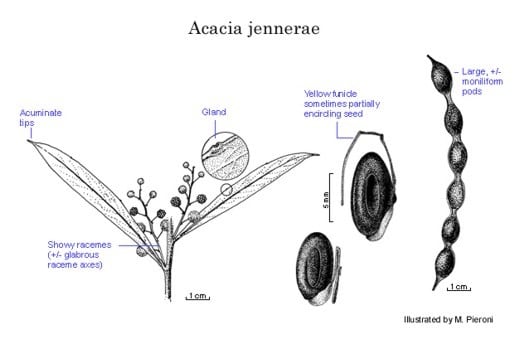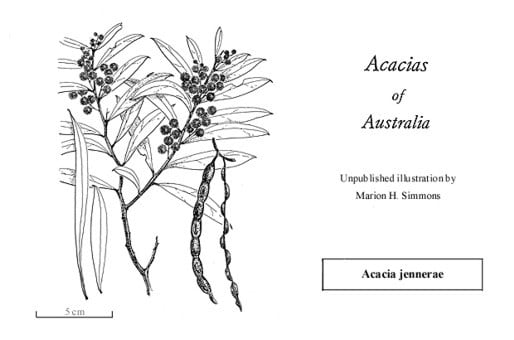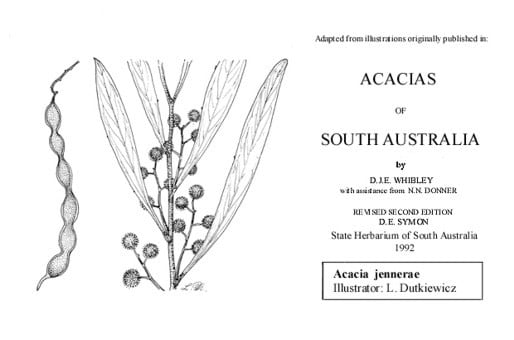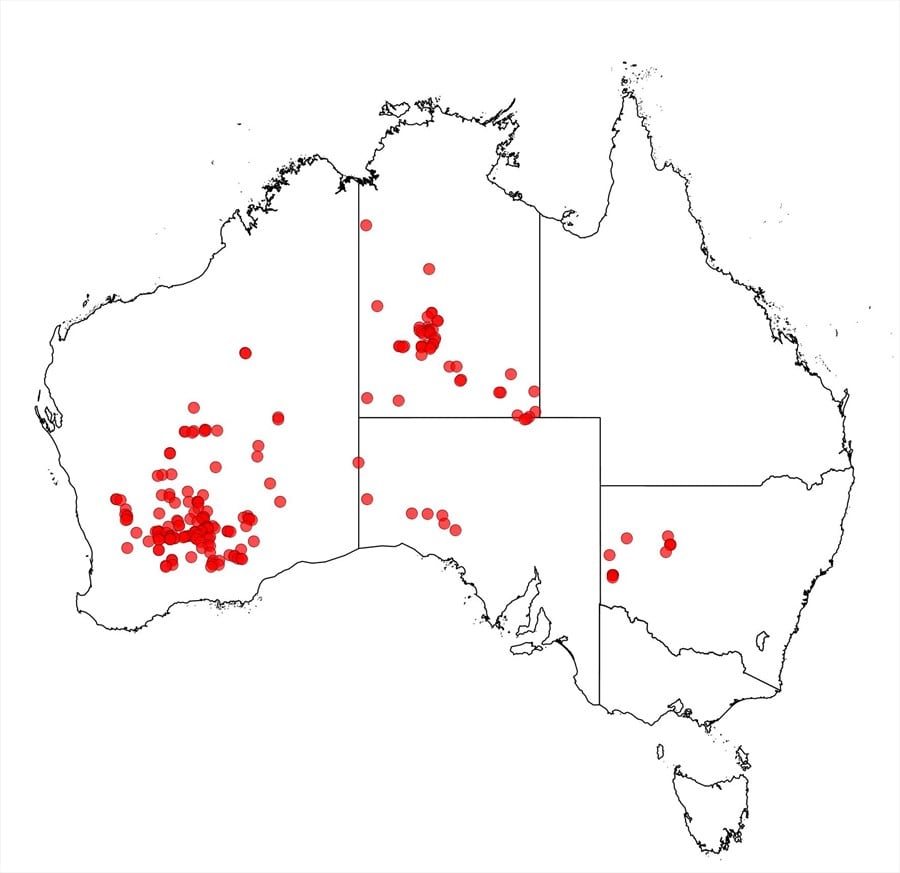Acacia jennerae Maiden
WATTLE
Acacias of Australia
Common Name
Coonavittra Wattle
Family
Fabaceae
Distribution
Sporadic in arid and semi-arid areas from near Kununoppin, W.A., through S.A. and N.T. to Wilcannia, N.S.W., and the Simpson Desert in far SW Qld.
Description
Shrub or tree 2–6 m high, often clonal. Bark red-brown to light brown. Branchlets glabrous. Phyllodes normally patent to inclined, narrowly elliptic to narrowly oblanceolate, ±straight, 5–11 (–15) cm long, 5–15 mm wide (lower ones sometimes 25 mm wide), short- or long-acuminate, thin, grey-green to glaucous, glabrous, with prominent midrib, finely penninerved; glands not prominent, (1–) 2 or 3, with the lowermost normally 3–10 mm above pulvinus. Raceme axes 1–4 (–6) cm long, often flexuose, usually ±glabrous; peduncles 2–7 mm long, slender, with indumentum as on raceme axes; heads globular, 20–30-flowered, light golden; bracteoles normally golden-fimbriolate. Flowers 5-merous; sepals c. 5/6-united. Pods moniliform to submoniliform, to 15 cm long, 6–8 mm wide, thinly coriaceous to firmly chartaceous, dark brown to blackish, glabrous. Seeds longitudinal, oblong, 6–8 mm long, dull, black; funicle sometimes 3/4 encircling seed, yellowish; aril ±clavate.
Phenology
Flowers Jan.-Aug., but mainly Mar.–July.
Specimens
W.A.: Mt Stevens, 10 km due NNE of Kununoppin, B.R.Maslin 4459 (PERTH); 32 km E of Southern Cross, P.G.Wilson 4043 (K, NSW, PERTH). N.T.: Nabberby Stn, P.K.Latz 5937 (PERTH). S.A.: Simpson Desert, R.W.Purdie 2823 (CANB). Qld: Simpson Desert, 100 km W of Birdsville, 13 Aug. 1999, P.Connelly (BRI). N.S.W.: 23.25 km S of Coonavittra Tank on Wilcannia–Cobar road, G.M.Cunningham 5401 (PERTH).
Notes
Acacia jennerae is regarded as a member of the ‘Acacia microbotrya group’ even though its funicle differs from most other members of the group. It is yellowish, short and either extends to just below the seed in a single fold or 3/4-encircles the seed but then is not reflexed back upon itself as occurs in A. microbotrya.
In the past the species has commonly been confused with A. microbotrya; their ranges overlap in the Burakin-Trayning area, W.A. Acacia jennerae is normally distinguished by its straighter phyllodes with more numerous glands (the lowermost 1–10 mm above the pulvinus) and its funicle. It is also related to Acacia sp. Kalannie (B.R.Maslin 7706), A. brumalis (especially Variant 2 of that species) and A. confluens, and is also similar to A. chrysella (Variant 2).
Acacia jennerae often has the habit of a small mallee eucalypt on account of its bushy, normally multistemmed habit and its bark and phyllode characters. Apart from its funicle (see below) the species is normally recognised by its ±glabrous raceme axes and peduncles and its rather spreading, ±straight, grey-green to glaucous phyllodes which commonly have 2 glands on their adaxial margins and which end in discrete, acuminate points. A few specimens are unusual in having relatively dense, pale yellow, appressed-puberulous raceme axes and peduncles or scarcely acuminate phyllodes or consistently uniglandular phyllodes: their status needs to be reassessed.
FOA Reference
Data derived from Flora of Australia Volumes 11A (2001), 11B (2001) and 12 (1998), products of ABRS, ©Commonwealth of Australia
Author
Minor edits by B.R.Maslin & J.Rogers
B.R.Maslin
This identification key and fact sheets are available as a mobile application:
URL: https://apps.lucidcentral.org/wattle/
© Copyright 2018. All rights reserved.
